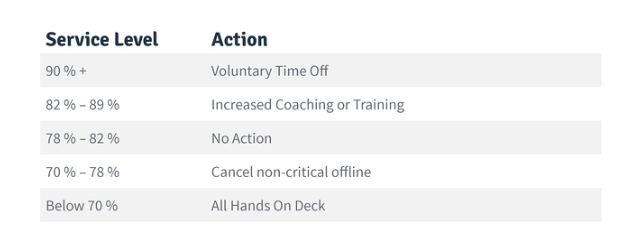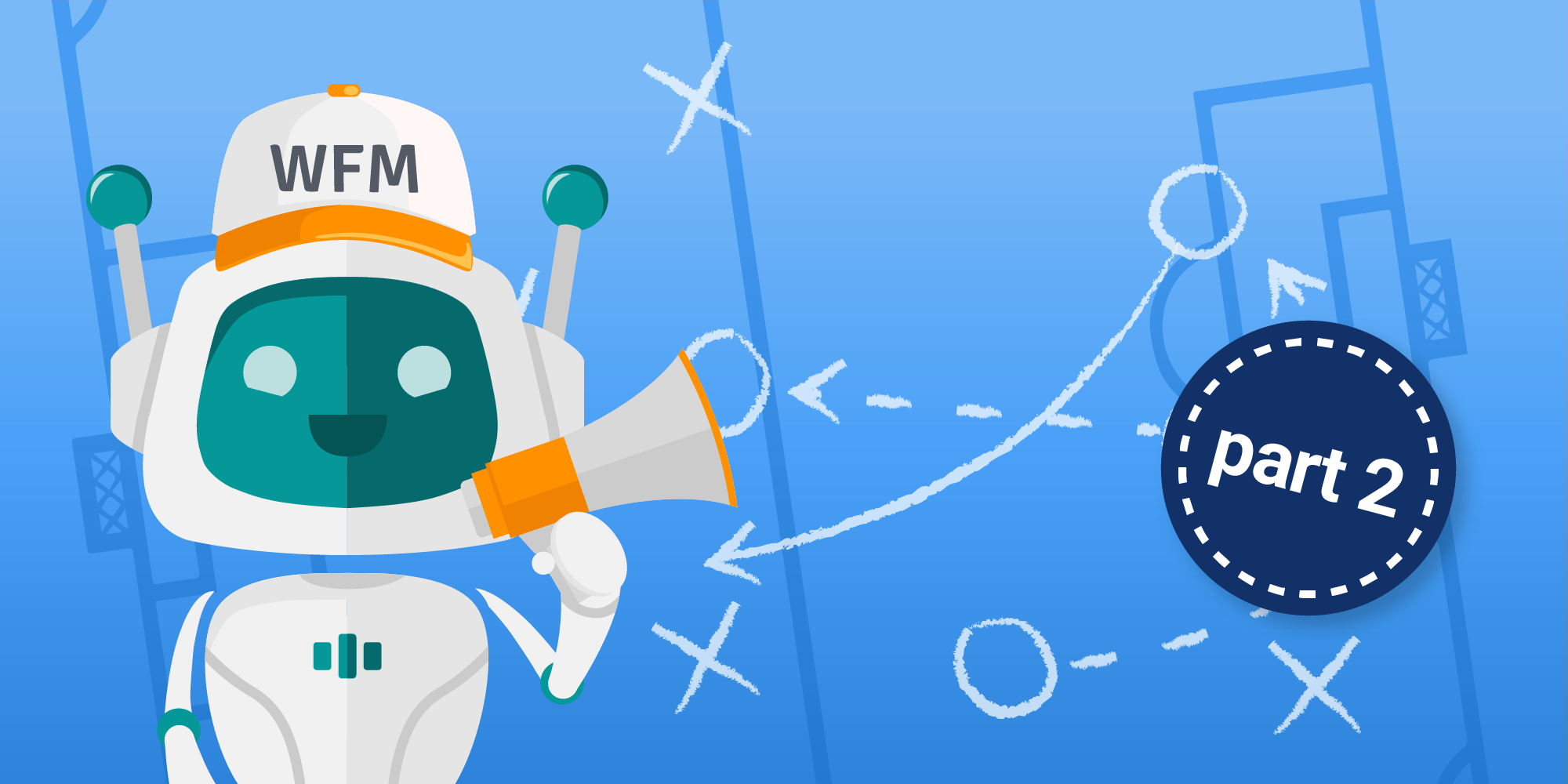In the first part of this article, we touched upon why call center service level is an important KPI for your business. We also discussed the two proven ways that help contact center professionals like you to improve service level in your contact center.
In this article, we'll zoom in on the tactics and strategies you can employ to improve service level in your contact center.
3. Increase schedule efficiency and adherence

Schedule efficiency is all about minimizing periods of over and understaffing in your contact center. Creating efficient schedules that are in line with your forecasted FTE demand/staffing requirement is indispensable for successful service level management.
Besides creating demand-oriented schedules based on your forecasts, it is equally important to pay attention to schedule adherence. You can have the best schedule that’s perfectly adapted to projected workload but if no one adheres to it, it’s worthless. Already a few minutes deviation from the plan, for instance, due to longer break times or spending time on non-work related tasks can break your schedule and negatively affect service level.
According to a recent WFM benchmark study, more than 20% of contact centers stated that they don’t measure schedule adherence.
To increase schedule efficiency, avoid the following common mistakes:
- Not making use of flexible schedules
- Failing to account for shrinkage in planning
- Employing few part-timers and short shifts
- Missing out on scheduling breaks properly
- Not measuring and reporting on schedule efficiency
- Obsessing about minimizing overtime
- Assuming that nobody wants to work unsocial hours
With WFM technology, you can make staffing gaps transparent with adherence monitoring even in real-time. However, let’s be real - you can rarely deliver a super-efficient schedule and ensure 100% adherence despite having professional software at your fingertips.
There’s always an unknown and uncontrollable variable - the human part. People may take longer on a break or get sick. What you can do is to plan ahead and consider this shrinkage in your staffing strategy as you collect more insights and intelligence in the process. Ultimately, this can benefit both occupancy rates and your service level in the long-run.
4. Focus on real-time management

Effective real-time management can have a significant impact on service level. It is often referred to intraday management and revolves around workload and performance monitoring by comparing plan vs actual throughout the day.
Real-time management allows planners to make intraday adjustments by uncovering deviations from the plan in real-time, thus mitigating over- and understaffing. In your everyday work as a planner, you will most likely experience that contact volumes or handle times are higher/lower than expected or the number of available agents simply does not match demand (for example due to unplanned absences).
Focusing on real-time management might be a no-brainer for some but many contact centers don’t really pay attention to it.
In fact, more than 25% of contact centers who participated in injixo’s WFM benchmark study stated that they don’t apply corrective action to their schedules on an intraday level when plan and actual do not match.
Here’s a few things that help you focus on real-time management:
- Monitor team and individual agent adherence
- Make ad-hoc changes to your schedules if necessary
- Configure adherence monitoring to your needs
- Allocate clear responsibilities to ensure focus on real-time management (e.g. team leaders, supervisors, etc.)
- Set up SL thresholds for alerts when plan doesn’t match demand to be able to react quickly to deviations
- Document clear instructions and ad-hoc actions to be taken when SL drops
Such an action plan can look as follows:

Real-time management can be a tedious task when done manually (i.e by using spreadsheets). But there’s a simple alternative. With professional WFM software, you are able to easily monitor all key variables that affect performance and service level in your contact center such as abandonment rate, ASA (average speed of answer), AHT, offered calls and staffing level.
Comprehensive dashboards allow you to analyze and visualize how actual compares to plan - no manual calculations needed. This way, you always stay up-to-date and ahead of the game giving you maximum control to hit your SL target.
5. Reduce employee turnover

This sounds like a logical thing to do in any business context. In fact, reducing agent attrition can, first of all, save your business a huge amount of money (i.e. recruiting and training cost). A Cornell study estimates that the cost hiring and onboarding an agent typically ranges between $5,000 - $7,500.
Second, keeping employee turnover low can sustain productivity and a healthy morale and among your workforce. Last but not least, retaining talent and highly skilled workers is essential if you want to maintain and leverage existing know-how which in case of a colleague’s departure goes down the drain.
Today, many contact centers suffer from high agent attrition. Statistics show that average annual turnover rates for agents in US contact centers range between 30-45% (QATC). You can calculate your contact center’s attrition rate by dividing the number of attritions by the average number of employees times 100.
Besides the above-mentioned reasons, agent turnover is a bad thing for your contact center:
- It hurts your service level since less people are available to take up calls, answer emails or engage in chat; thus harming your center’s ability to match service demand with supply.
- It leads to agent burnout and decreases in productivity since you still need to balance your resource deficit. Workload is then allocated to the remaining staff who struggle to handle additional work and may already be flooded with calls.
- Point 2 can further result in decreasing morale, increased absenteeism due to sickness and even higher attrition rates. And the vicious cycle continues.
To mitigate employee turnover in your contact center and keep agent attrition at a minimum to sustain your capabilities to achieve service level, there are a couple of things you can do:
- Understand the reasons why your agents are leaving the business
- Collect feedback about what makes your employees happy (e.g. run a periodic eNPS survey among front-line staff, empower team leaders to held regular 1on1 meetings).
- Reduce over hours, encourage breaks and vacation to avoid agent burnout
- Employ flexible staffing strategies and offer work-from-home options to give agents more freedom about working hours
- Offer training and development options as well as designated career paths to drive intrinsic motivation
- Engage employees regularly because only happy agents can create happy customers
Now it’s on you to improve contact center service level
Improving call center service level can be a tough job. There are various ways as well as different tactics and solution strategies you can utilize to get it right.
Sometimes you just need to turn the right screws, try out different approaches and select the one that works best for you. And sometimes, you find that an integrated approach and mixture of multiple tactics does the trick. The 5 aforementioned ways to improve SL should thus provide you with a good overview of where to start.
Need help with successful service level management? Explore how proven and powerful WFM software can help you set new standards to both achieve and improve service levels effectively.
Did you find the article interesting and would like to share it with your colleagues? Download the article as a PDF.





